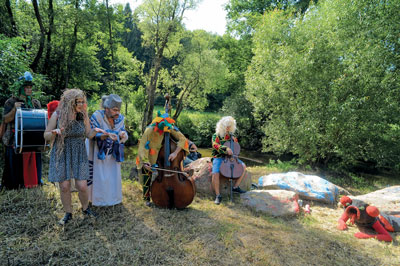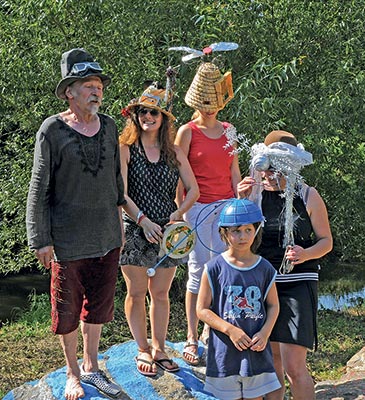Hat Procession(1)
3 August 2013, 2nd station
On a blazing August Saturday, when the temperature reached 37 degrees Celsius, a group of people met in Staré Hobzí in order to set off on a pilgrimage to The Wishing Stones, some 2 km distant. They wore fantasy hat creations. According to legend, the pilgrims bring their wishes to the 2nd station of Kristek Thaya Glyptotheque written on scrolls, which they insert in the holes of this sculpture made up of seven boulders. In the Hat Procession, the pilgrims carried their wishes hidden under their hats. Here once again, there is the motif of a magical item hidden in a case or costume, this time under a hat, which also served as protection from the blazing sun on the route. The magical effect of the concealed item was reinforced by the making of a pilgrimage.
 To an accompanying drumbeat (which in ancient cultures was considered an intermediary between man and the spirit), they set off down the road leading from the village. The journey was enlivened by the vocal performance of costumed characters – the physical poet Petr Váša and the singer Pavlína Švestková. More and more people joined in, and the singing procession turned on to the forest track leading to the woods.
To an accompanying drumbeat (which in ancient cultures was considered an intermediary between man and the spirit), they set off down the road leading from the village. The journey was enlivened by the vocal performance of costumed characters – the physical poet Petr Váša and the singer Pavlína Švestková. More and more people joined in, and the singing procession turned on to the forest track leading to the woods.
 The sounds of a cello and double bass(2) could be heard from The Wishing Stones in the clearing near the river that the pilgrims were approaching. The procession arrived at the pilgrimage site, a vocal-musical improvisation inspired by this station was played and the spectators joined in. A massive red and black worm appeared amongst the stones, just as on the day when this station was opened six years earlies. The paintwork of the stones was symbolically renewed, and then the creator of Kristek Thaya Glyptotheque appeared from it in a cloud of purple fog. The pilgrims inserted their scrolls in The Wishing Stones and whilst still wearing their hats they took a purifying bath in the Thaya.
The sounds of a cello and double bass(2) could be heard from The Wishing Stones in the clearing near the river that the pilgrims were approaching. The procession arrived at the pilgrimage site, a vocal-musical improvisation inspired by this station was played and the spectators joined in. A massive red and black worm appeared amongst the stones, just as on the day when this station was opened six years earlies. The paintwork of the stones was symbolically renewed, and then the creator of Kristek Thaya Glyptotheque appeared from it in a cloud of purple fog. The pilgrims inserted their scrolls in The Wishing Stones and whilst still wearing their hats they took a purifying bath in the Thaya.
 Pilgrimages or processions tend to be a significant custom bringing society together, and they give their members a feeling of solidarity with the environment, with nature and with values. The spiritual dimension of a jointly taken journey lifts man above day-to-day reality and gives him strength to continue the further journey of life.
Pilgrimages or processions tend to be a significant custom bringing society together, and they give their members a feeling of solidarity with the environment, with nature and with values. The spiritual dimension of a jointly taken journey lifts man above day-to-day reality and gives him strength to continue the further journey of life.
Text: Iveta K. Pavlovičová, Barbora Půtová
Iveta K. Pavlovičová (born 1974) is a Czech theatre studies specialist and director of the Research Institute for Communication in Arts in Brno.
She has long been engaged in the postmodern theatre and its sources. She is the author of scientific-research projects supported by the Grant Agency of the Academy of Sciences of the Czech Republic, Fund for Development of Universities, Czech Literary Fund and the European Union (European Fund for Regional Development), as well as theatre projects supported by the Ministry of Culture of the Czech Republic and the Czech-German Fund for the Future. She participated in the 3rd and 4th International Symposium of Theatre Anthropology at the Janáček Academy of Music and Performing arts Brno (JAMU), where she lectured in the years 2003–2004. She also gave a lecture at the Masaryk University Institute of Anthropology in Brno. Since 2009, she has worked on the forming of an exhibition programme at the Baroque Palace of Riegersburg.
She published the article Modely v nás a možnost jejich změny (Our Inner Models and the Possibility to Change Them) in the magazine Vesmír (2/2005) and a teaching video programme for high schools. She is the author of the textbook Tělo, znak a rytmus (Body, Sign and Rhythm) for JAMU and the book Divadlo Neslyšících a nové cesty (Theatre of the Deaf and the New Ways, 2002) that was published as part of a publication project supported by the Grant Agency of the Academy of Sciences of the Czech Republic.
Barbora Půtová (born 1985) is a Czech anthropologist and art historian lecturing at the Faculty of Arts, Charles University in Prague.
She deals with history of culture, artwork and cultural heritage. Other fields of her expert interest include historical anthropology, visual anthropology and anthropology of art.
She has published dozens of articles and experts studies as well as several expert monographs such as Pravěké umění (Prehistoric Art, co-authors Jean Clottes and Václav Soukup, 2011), Félicien Rops: enfant terrible dekadence (Félicien Rops: Enfant Terrible of Decadence, 2013), Kristkova podyjská glyptotéka (Kristek Thaya Glyptoheque, co-author Iveta K. Pavlovičová, 2013), The Genesis of Creativity and the Origin of the Human Mind (co-edited by Václav Soukup, 2015) or Královská cesta: všední i sváteční život v proměnách času (The Royal Route: Ordinary and Festive Life Over the Course of Time, 2016).
In her monograph Félicien Rops she offers the first comprehensive view of the life and work of one of the most prominent representatives of decadence and symbolism; in her last book Královská cesta (The Royal Route) she writes about the creation, development, meaning and historical changes of the Royal Route in Prague. In her book Skalní umění (Rock Art, 2015), she published the results of her field research of Palaeolithic art that she carried out at archaeological sites in France and Portugal.
At presents she is carrying out research of African rock art in the High Atlas Mountains of Morocco.
The event was a part of the project Kristek Thaya Glyptotheque – Cultural and Tourist Destination.
Members of the Brno Philharmonic Orchestra Lukáš Svoboda (cello) and Marek Švestka (double bass) participated in costumed roles.
 To an accompanying drumbeat (which in ancient cultures was considered an intermediary between man and the spirit), they set off down the road leading from the village. The journey was enlivened by the vocal performance of costumed characters – the physical poet Petr Váša and the singer Pavlína Švestková. More and more people joined in, and the singing procession turned on to the forest track leading to the woods.
To an accompanying drumbeat (which in ancient cultures was considered an intermediary between man and the spirit), they set off down the road leading from the village. The journey was enlivened by the vocal performance of costumed characters – the physical poet Petr Váša and the singer Pavlína Švestková. More and more people joined in, and the singing procession turned on to the forest track leading to the woods. The sounds of a cello and double bass(2) could be heard from The Wishing Stones in the clearing near the river that the pilgrims were approaching. The procession arrived at the pilgrimage site, a vocal-musical improvisation inspired by this station was played and the spectators joined in. A massive red and black worm appeared amongst the stones, just as on the day when this station was opened six years earlies. The paintwork of the stones was symbolically renewed, and then the creator of Kristek Thaya Glyptotheque appeared from it in a cloud of purple fog. The pilgrims inserted their scrolls in The Wishing Stones and whilst still wearing their hats they took a purifying bath in the Thaya.
The sounds of a cello and double bass(2) could be heard from The Wishing Stones in the clearing near the river that the pilgrims were approaching. The procession arrived at the pilgrimage site, a vocal-musical improvisation inspired by this station was played and the spectators joined in. A massive red and black worm appeared amongst the stones, just as on the day when this station was opened six years earlies. The paintwork of the stones was symbolically renewed, and then the creator of Kristek Thaya Glyptotheque appeared from it in a cloud of purple fog. The pilgrims inserted their scrolls in The Wishing Stones and whilst still wearing their hats they took a purifying bath in the Thaya. Pilgrimages or processions tend to be a significant custom bringing society together, and they give their members a feeling of solidarity with the environment, with nature and with values. The spiritual dimension of a jointly taken journey lifts man above day-to-day reality and gives him strength to continue the further journey of life.
Pilgrimages or processions tend to be a significant custom bringing society together, and they give their members a feeling of solidarity with the environment, with nature and with values. The spiritual dimension of a jointly taken journey lifts man above day-to-day reality and gives him strength to continue the further journey of life.


